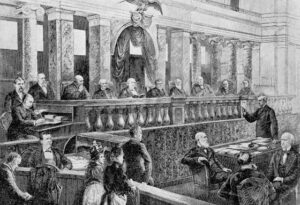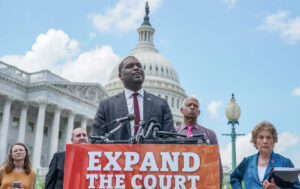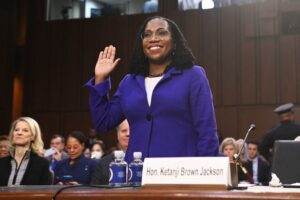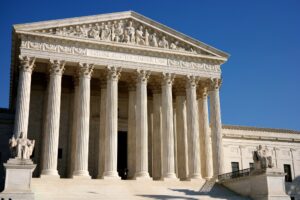 This is part 3 of the Saving the Court series. I would encourage you to read previous posts, including
This is part 3 of the Saving the Court series. I would encourage you to read previous posts, including
In this post, I’ll examine the history of Supreme Court reform efforts, beginning with the earliest days of the Court right up until present day.
Constitutional Language
Article III, § I of the United States Constitution creates the Supreme Court and grants to Congress the right to create other courts as they see fit. It reads:
“The judicial Power of the United States, shall be vested in one supreme Court, and in such inferior Courts as the Congress may from time to time ordain and establish. The Judges, both of the supreme and inferior Courts, shall hold their Offices during good Behaviour, and shall, at stated Times, receive for their Services, a Compensation, which shall not be diminished during their Continuance in Office.”
Article III, § II of the Constitution delineates the jurisdiction of the Supreme Court, which includes:
- Cases involving the United States Constitution and treaties,
- Cases affecting ambassadors and diplomats, and
- Cases involving admiralty and maritime law.
Finally, Article II, § II grants to the Executive the power to appoint Justices to the Supreme Court and other courts that Congress may create, with the advice and consent of the Senate. “[The President] shall have Power, by and with the Advice and Consent of the Senate, to make Treaties, provided two thirds of the Senators present concur; and he shall nominate, and by and with the Advice and Consent of the Senate, shall appoint Ambassadors, other public Ministers and Consuls, Judges of the supreme Court, and all other Officers of the United States, whose Appointments are not herein otherwise provided for, and which shall be established by Law: but the Congress may by Law vest the Appointment of such inferior Officers, as they think proper, in the President alone, in the Courts of Law, or in the Heads of Departments.”
Federalist 78 and Brutus XV
In 1788, Alexander Hamilton, writing under the pseudonym “Publius,” in Federalist 78, offered some additional thoughts on the judicial branch of the proposed government.
“Whoever attentively considers the different departments of power must perceive, that, in a government in which they are separated from each other, the judiciary, from the nature of its functions, will always be the least dangerous to the political rights of the Constitution; because it will be least in a capacity to annoy or injure them. The Executive not only dispenses the honors, but holds the sword of the community. The legislature not only commands the purse, but prescribes the rules by which the duties and rights of every citizen are to be regulated. The judiciary, on the contrary, has no influence over either the sword or the purse; no direction either of the strength or of the wealth of the society; and can take no active resolution whatever. It may truly be said to have neither FORCE nor WILL, but merely judgment; and must ultimately depend upon the aid of the executive arm even for the efficacy of its judgments.” (Emphasis added)
Hamilton saw the judiciary as an intermediary between the people and the Congress, whose role, among other things, was to keep Congress within the authority assigned to it by the Constitution. Not everyone agreed, and a hearty public debate ensued regarding the judiciary and its relation to the other branches of government, as well as to the people.
By contrast, Robert Yates, an anti-federalist, writing as “Brutus” in Brutus XV, wrote that the framers of the Constitution followed the British by making federal judges independent by granting them their positions during good behavior, but then failed to follow the British model of “instituting a tribunal in which their errors may be corrected.” In other words, Yates felt that the framers had made a grave error in giving judges lifetime appointments (“during good Behaviour”) without also giving the legislature the power to override judicial decision they disagreed with. For Yates, the framers were setting up a government where the judiciary ruled over and controlled the legislative branch, as well as a judiciary that was disconnected from and unaccountable to the people.
“I do not object to the judges holding their commissions during good behaviour. I suppose it a proper provision provided they were made properly responsible. But I say, this system has followed the English government in this, while it has departed from almost every other principle of their jurisprudence, under the idea, of rendering the judges independent; which, in the British constitution, means no more than that they hold their places during good behaviour, and have fixed salaries, they have made the judges independent, in the fullest sense of the word. There is no power above them, to controul any of their decisions. There is no authority that can remove them, and they cannot be controuled by the laws of the legislature. In short, they are independent of the people, of the legislature, and of every power under heaven. Men placed in this situation will generally soon feel themselves independent of heaven itself.”
History of Supreme Court Reform Efforts
When the new government began operating on March 4, 1789, many questions remained, including questions surrounding the judiciary. Article III established the Supreme Court, but the drafters of the Constitution were unable to agree on the creation of inferior courts, what types of cases the federal courts would hear, how the Supreme Court would relate to state courts, and how many Justices would sit on the Supreme Court. Rather than coming to an agreement, in what has come to be known as the “Madisonian Compromise,” the drafters left it to Congress to decide these issues.
The first Congress, which convened in New York in April 1789, immediately set to work crafting legislation to establish the federal courts. A Senate Committee made up of ten senators drafted an act that was then circulated to top lawyers, jurists, and leaders of the day for input. The Senate then set about creating a compromise bill that attempted to balance the concerns of the Federalists, who favored a strong federal judiciary, with those of the Anti-Federalists, who wanted to assure state autonomy. After debate, and several rounds of amendments, the resulting bill passed both the Senate and the House. On September 24, President George Washington signed the Judiciary Act of 1789 into law.
The Act established a six Justice Supreme Court consisting of one Chief Justice and five associate Justices. It also set out the Court’s original and appellate jurisdiction, and it placed the Supreme Court at the top of the hierarchy of the nation’s courts, including superior to state courts. In addition, the Act established thirteen federal district courts, one for each state, as well as one each for Maine and Kentucky, which had not yet become states. Each district court was staffed by one district judge with jurisdiction primarily over admiralty cases and minor federal crimes. The Act also established three circuit courts—eastern, middle, and southern—which were each staffed by a circuit court judge and two Supreme Court Justices who were expected to “ride circuit” to the outlying courts. Both the district court and the circuit courts were primarily trial courts, although the circuit courts were given limited appellate jurisdiction.
The Supreme Court first convened on February 2, 1790, at New York’s Royal Exchange. Chief Justice John Jay gaveled to order the Court, which on that day consisted of just three associate Justices. Two others were unable to attend. Even before the Supreme Court first convened, Congress was already debating reform proposals that sought to restructure it, alter its jurisdiction, and further empower inferior federal courts. More often than not, the reform efforts came up short, but that didn’t stop Congress, or the public, from proposing changes to the judiciary.
The first reform proposal to actually become law was the Judiciary Act of 1801. The Act made several changes to the judiciary, including expanding the jurisdiction of inferior federal courts to allow them to hear all cases arising under federal law; increased the number of district and circuit courts, including adding a new sixth circuit; created sixteen new circuit judgeships; and ended the circuit-riding duties of Supreme Court Justices. The number of Supreme Court Justices was reduced to five upon the next vacancy, which was nominally justified because Justices would no longer have to ride circuit, meaning fewer Justices were needed. However, the truth is it was almost certainly done for political reasons.
Sitting President John Adams, a Federalist, was not running for re-election, so Congress, where Federalists were a majority, did not want to risk a President from another party having the ability to add a Justice to the Supreme Court. However, contrary to popular belief, the change in the number of Supreme Court Justices was not motivated by Thomas Jefferson’s Presidential victory. In fact, the Act was debated and passed months before Jefferson and his fellow Democratic-Republicans swept into office.
After just one year, the Judiciary Act of 1801—along with nearly all of its reforms—was repealed and replaced by the Judiciary Act of 1802. The new Act reversed everything the Act of 1801 implemented, with the exception of adding a sixth circuit. The number of Supreme Court Justices was restored to six, and for the first time, the number of Justices corresponded to the number of federal circuits.
Marbury v. Madison
William Marbury was one of forty-two people appointed as a Justice of the Peace for the District of Columbia and Alexandria, Virginia by President Adams in the waning days of his administration. All appointees were confirmed by the Senate, and all but four of those appointments were processed by John Marshall, who was serving simultaneously as Secretary of State and as the newly confirmed Chief Justice of the Supreme Court.
When Thomas Jefferson became the third President of the United States, he instructed his new Secretary of State, James Madison, to hold all commissions that had not yet been processed. One of those four appointments was for William Marbury, who ultimately sued under a writ of mandamus, asking the Court to force Madison to deliver his commission.
In Marbury v. Madison (5 U.S. 137), the Court decided that it could not grant the petitioner’s request because the law that gave the Court jurisdiction to rule in the case was itself unconstitutional. Chief Justice John Marshall spoke for the Court, establishing the Court’s authority to declare acts of Congress unconstitutional. Neither the Constitution nor legislation gives the Court this power explicitly. Instead, Marshall found that the Constitution implicitly gave the power of judicial review to the Court.
Although the Constitution does not specifically confer the power of judicial review on the Court, Chief Justice Marshall (and others) saw in the combined force of Article III, The Supremacy Clause of Article VI, longstanding Anglo-American legal practice, and the nature of the United States Constitution, that judicial review was within the Court’s power. “Chief Justice Marshall established judicial review as a principle of American law, claiming for the Court—in the name of the Constitution and the people—the power ‘to say what the law is.” (Presidential Commission on the Supreme Court Of The United States 2021, 41)
“It is emphatically the province and duty of the judicial department to say what the law is. . . So if a law be in opposition to the constitution; if both the law and the constitution apply to a particular case, so that the court must either decide that case conformably to the law, disregarding the constitution; or conformably to the constitution, disregarding the law; the court must determine which of these conflicting rules governs the case. This is of the very essence of judicial duty.” (Marbury v. Madison 1803)
Post-Marbury Efforts to Reform the Supreme Court
In 1807, the number of Justices was once again increased to seven to correspond with the addition of a seventh federal circuit. If it wasn’t obvious previously, it became obvious in 1807 that the number of Supreme Court Justices and the number of federal circuits were understood as necessarily linked.
As the country grew and expanded westward, the need for additional federal courts expanded. The Judiciary Act of 1837 increased by two the number of federal circuits, as well as the number of Supreme Court Justices. While the addition of circuits was needed, the timing was purely political. The Democratic Congress passed the Judiciary Act of 1837 on March 3, 1837, the final day of President Andrew Jackson’s term in office, giving Jackson the opportunity to appoint two additional Justices before he returned home to Tennessee.
The succession of slave-holding states and the beginning of the Civil War prompted further reform of the judiciary. Not only was the country at war, but half of the Justices on the Supreme Court at the time were from southern states. President Abraham Lincoln knew he had to make changes to the Judiciary in order to make the Court more friendly to his agenda.
In an 1861 address, President Lincoln contended that the country had outgrown its present judicial system, and he called for Congress to sever the link between the number of circuits and the number of Justices on the Supreme Court. Congress only partially followed Lincoln’s lead. As requested, in 1862 and 1863, Congress reorganized and increased the number of federal circuits to ten. But rather than accede to Lincoln’s wishes, they also added a tenth seat to the Supreme Court.
In 1866, with the Civil War ended and the country reunited, Congress once again undertook court reform. With the Judicial Circuits Act of 1866, the Republican majority in Congress reduced the number of circuits from ten to nine and mandated that the number of Supreme Court Justices be gradually reduced from ten to seven. This not only de-coupled the traditional linkage between the number of circuits and the number of Supreme Court Justices, it also accomplished the political goal of preventing incoming President Andrew Johnson, a Democrat, from appointing any Justices to the Court.
In the years during and shortly after the Civil War, the federal judiciary experienced a profound expansion of jurisdiction. The most important changes were:
- Removal Jurisdiction – Allowed certain cases that began in state court to be taken to federal court;
- Writ of Habeas Corpus – Allowed federal courts to issue writs on behalf of prisoners held by state authorities in violation of federal law; and
- Federal Question – Also known as “arising under” jurisdiction.
As a result, in 1890, the Supreme Court was inundated with cases. The number of cases rose from 310 in 1860 to more than 1800 just thirty years later. Calls for reform to the Court were plentiful, with proposals for an 18-member Court, a new level of federal appellate court, and splitting the Supreme Court into three divisional panels among the recommendations.
In 1891, Congress passed the Circuit Court of Appeals Act, also known as the “Evarts Act.” While resisting calls to increase the size of the Supreme Court, the Act eliminated the duty of Supreme Court Justices to ride circuit, and created intermediate courts of appeal, which drastically reduced the case load of the Supreme Court.
Calls for reforms continued, and in 1912, in his campaign for the presidency, Theodore Roosevelt proposed a new law that would give the people the power to overrule court decisions that found legislation unconstitutional. Due to pushback, Roosevelt limited his reform recommendation to just state courts, but behind closed doors, he confided that he’d like the reform measure to apply to federal courts as well.
Roosevelt’s campaign proved unsuccessful, but progressive members of Congress continued to push the idea of recalling court decisions. Senator Robert Owen (D-OK) proposed legislation that would allow Congress to remove lower federal court judges and Supreme Court Justices with a simple majority vote, and Senator Robert LaFollette (R-WI) proposed a Constitutional amendment that would allow Congress to override court decisions that invalidated legislation. Neither proposal succeeded, but they are both illustrative of the ongoing debate over reforms of the judiciary.
FDR’s Court Packing Plan
Perhaps the most famous Court reform proposal—at least when it comes to increasing the size of the Court—occurred in 1937 by President Franklin D. Roosevelt. To fully understand Roosevelt’s plan to transform the Court, it’s necessary to put it into context.
Roosevelt was elected to the presidency in 1932 while the United States was in the throes of the Great Depression. In campaigning for the nation’s highest office, Roosevelt promised Americans a “New Deal” designed to boost the national economy and reverse the depression that had gripped the nation. The plan called for greater government involvement in the economy than had been common previously.
After being elected, Roosevelt and the 73rd Congress passed the Economy Act, a relatively minor piece of legislation that may have had a big impact. The Economy Act cut many government salaries, including cutting in half the pensions received by retired Supreme Court Justices. The lower retirement benefits resulted in Supreme Court Justices William Van Devanter and George Sutherland each curtailing their retirement plans.
There’s no way to know for certain if the Economy Act led Van Deventer, Sutherland, or other Justices to hold a grudge against Roosevelt, although some scholars have posited that it did play a role. In the very least, the Economy Act kept Justices on the Court that were unfriendly to the President’s legislative agenda, and prohibited him from appointing more sympathetic Justices.
The Supreme Court in the early and mid-1930s was made up of four conservative Justices (Willis Van Devanter, George Sutherland, James Clark McReynolds, and Pierce Butler), known as “The Four Horsemen;” three liberal Justices (Louis Brandeis, Benjamin Cardozo, and Harlan Fiske Stone), dubbed the “Three Musketeers”; and two “swing votes” (Chief Justice Charles Evans Hughes and Owen Roberts). Early in Roosevelt’s tenure, the Court was decidedly opposed to the President’s New Deal legislation.
In 1935, the Court ruled against Roosevelt in:
- Railroad Retirement Board v. Alton Railroad Company (295 U.S. 330) – Case challenging the constitutionality of the compulsory retirement and pension system for all carriers subject to the Interstate Commerce Act;
- Humphrey’s Executor v. United States (295 U.S. 602) — Case regarding whether or not the President had the authority to remove executive officials of a quasi-legislative and quasi-judicial administrative bodies for reasons other than those allowed by Congress;
- Louisville Joint Stock Land Bank v. Radford (295 U.S. 555) – Case involving the constitutionality of the Frazier-Lempke Farm Bankruptcy Act;
- Schechter Poultry Company v. United States (295 U.S. 495) – Case involving the constitutionality of the National Industrial Recovery Act of 1933; and
- United States v. Butler (297 U.S. 1) – Case involving the taxing power of the federal government that found the Agricultural Adjustment Act to be unconstitutional.
The decisions in Humphrey’s Executor, Louisville Joint Stock Bank, and Schechter Poultry Company were all announced on what has come to be known as “Black Monday” (May 27, 1935), and all decisions were 9-0.
Roosevelt was angry. Not only did he feel that these decisions were rendered out of spite, but he feared that the Court stood in the way of him fully implementing his New Deal legislation, a prospect he believed would further damage the country’s economy.
In November 1936, Roosevelt won an overwhelming victory in the Presidential Election, cementing his mandate to move forward with more New Deal legislation. One month later, in December 1936, the Supreme Court heard oral arguments in the case of West Coast Hotel Co. v. Parrish (300 U.S. 379). The case involved the constitutionality of a minimum wage law and was very important to the future of Roosevelt’s New Deal legislation.
The President feared that the Court would continue to block his legislation, so on February 5, 1937, he introduced the Judicial Procedures Reform Bill of 1937, which became known colloquially as the “Court packing” plan. On March 9, 1937, Roosevelt justified his plan in a Fireside Chat.
Roosevelt claimed that his plan to expand the Court was designed to relieve overcrowded court dockets. In reality, Court expansion was a way for Roosevelt to head off his concerns that the Court would strike down his Fair Labor Standards Act, the National Labor Relations Board, and the Social Security Act, legislation he and the Democrats in Congress had fought so hard to pass.
Roosevelt’s plan called for the addition of one Supreme Court Justice, up to a maximum of fifteen, for every one that stayed on the Court for six months past their seventieth birthday. This plan encouraged, but did not require, Justices to retire when they reached an age that is usually associated with a slower lifestyle and, in some cases, reduced mental capabilities. The plan, if approved, would have allowed Roosevelt to add six Justices, since Chief Justice Hughes, and Justices Brandeis, Van Devanter, Sutherland, McReynolds, and Butler were all past their seventieth birthdays.
Following Roosevelt’s Fireside Chat, support for his Court expansion plan received lukewarm support among voters, and bi-partisan opposition in Congress. Although Roosevelt’s Court expansion legislation was stalled in Congress, things in the Court started to break Roosevelt’s way. On March 29, 1937—which came to be known as “White Monday”—the Court handed down three decisions that bolstered Roosevelt’s New Deal effort.
- West Coast Hotel Co. V. Parrish (300 U.S. 379) – The Court upheld the constitutionality of minimum wage legislation;
- Wright v. Vinton Branch (300 U.S. 440) – The Court upheld the constitutionality of the newly passed Frazier-Lempke Act as it concerned farmer bankruptcy; and
- Virginian Railway Co. v. Federation (300 U.S. 515) – The Court upheld the constitutionality of the revamped Railway Labor Act.
History has concocted a narrative, commonly known as the “switch in time that saved nine,” that had Justice Roberts changing his vote in an attempt to defeat Roosevelt’s Court packing plan. The truth is, Roberts voiced his desire to support the constitutionality of minimum wage laws once oral arguments in the Parrish case were complete, months before Roosevelt introduced his Court packing plan. In other words, Roberts’ vote was based on his judicial philosophy, not political expediency.
Justice Van Devanter retired in May 1937 allowing Roosevelt to appoint a Justice to the Court friendly to his legislation. With Van Devanter gone and Roberts voting with the Court’s liberal wing, the President’s New Deal legislation was safe. In addition, the Court packing plan, which was never passed into law, became a footnote in history.
Post-World War II Court Reform Efforts
In 1956, in the wake of the Supreme Court’s decision in Brown v. Board of Education (347 U.S. 483), several Constitutional amendments were proposed to try to undo what the Court had done in Brown. Among the proposals was an amendment making the Senate the final court of appeal and giving it the authority to review decisions of the Supreme Court; an amendment setting term limits for federal judges; a procedure that allowed Court decisions that weakened states’ rights to be overturned if one-fourth of the states disapproved; a “Court of the Union” made up of state supreme court judges with the power to review and overturn decisions made by the Supreme Court involving states rights; and an amendment reserving to the states the sole and exclusive jurisdiction over cases involving the public schools of the various states. None of these proposals were passed.
In 1963 and 1964, the Court heard a series of six cases—known collectively as the Reapportionment cases—that involved the makeup of legislative districts in various states. The Court’s decisions effectively invalidated the legislative districts in every state. Rather than being apportioned by political subdivisions, such as the county, the Court said that the districts had to be based on equal population districts. In the aftermath of the decisions, Illinois senator Everett Dirksen led a movement to amend the Constitution to allow the Senate to override Supreme Court decisions, but the effort ultimately fell short.
During the Democratic Party Primary leading up to the 2020 Presidential Election, court reform became a hot topic again. Democrats felt that Republicans had stolen at least one, maybe two, Supreme Court nominations from them, and they were anxious to support just about any proposal that would help turn the tables. Candidates such as Sen. Kamala Harris (D-CA), Mayor Pete Buttigieg, and Sen. Elizabeth Warren (D-MA) were all open to adding seats to the Supreme Court and applying term limits to Supreme Court Justices. For his part, Candidate Joe Biden refused to support either expanding the Court or term limits. Instead, he committed to creating a commission of legal experts to study the various reform proposals to see if any of them could or should be implemented. It’s highly likely that forming a committee to study the issue was a way for Biden to avoid committing to any particular course of action. Regardless, he was good to his word, and on April 9, 2021, President Biden signed Executive Order 14023 establishing the Presidential Commission on the Supreme Court of the United States.
Throughout our nation’s history—in fact, starting before the Supreme Court even opened for business—there have been calls for reforms to the judiciary generally, and the Supreme Court specifically. The reforms we consider today are not new. What is new is the highly partisan Court, as well as the highly partisan nomination and confirmation process. In the next post, I’ll look at the nomination and confirmation process, and examine proposals to make it fairer and more effective.

 I want to take a short break from the Saving the Court project to share a few thoughts about country music star Jason Aldean and his controversial song, “Try That in a Small Town.” But first, let me tell you about Henry Choate.
I want to take a short break from the Saving the Court project to share a few thoughts about country music star Jason Aldean and his controversial song, “Try That in a Small Town.” But first, let me tell you about Henry Choate.
 This is part 5 of the Saving the Court series. I would encourage you to read previous posts, including
This is part 5 of the Saving the Court series. I would encourage you to read previous posts, including
 This is part 3 of the Saving the Court series. I would encourage you to read previous posts, including
This is part 3 of the Saving the Court series. I would encourage you to read previous posts, including
 The Supreme Court term ended this past week with the announcement of several controversial decisions. Along with the end of the term came word that the court’s approval rating had hit an all-time low. To be sure, Americans are not supportive of many of the decisions being made by the court. But more importantly, they are not happy with the way the court is reaching those decisions, or how the justices are conducting themselves outside of court.
The Supreme Court term ended this past week with the announcement of several controversial decisions. Along with the end of the term came word that the court’s approval rating had hit an all-time low. To be sure, Americans are not supportive of many of the decisions being made by the court. But more importantly, they are not happy with the way the court is reaching those decisions, or how the justices are conducting themselves outside of court. I was in my fifties the first time I ate at a Waffle House. Until then, Waffle House, to me, was a place where addicts, the homeless, and the down-and-out ate. I know that doesn’t make sense. Heck, generally speaking, the homeless don’t normally eat their meals in restaurants. I don’t mean to besmirch anyone. I just didn’t think Waffle House restaurants were for me. Boy, was I wrong.
I was in my fifties the first time I ate at a Waffle House. Until then, Waffle House, to me, was a place where addicts, the homeless, and the down-and-out ate. I know that doesn’t make sense. Heck, generally speaking, the homeless don’t normally eat their meals in restaurants. I don’t mean to besmirch anyone. I just didn’t think Waffle House restaurants were for me. Boy, was I wrong.
 If you’ve never heard of T.J. Newman, you can be forgiven. Until fairly recently, T.J. was a flight attendant. To be more precise, she was a flight attendant with a dream. T.J. wanted to be a writer. In her spare time–and at times while she was working as a flight attendant–T.J. wrote a novel about a pilot who has to choose between purposely crashing his plane, killing everyone onboard, or having terrorists kill his family. It seemed like a great plot idea. Agents disagreed. Forty-one agents turned her down. Many of them didn’t even bother to read her writing. Forty-one rejections.
If you’ve never heard of T.J. Newman, you can be forgiven. Until fairly recently, T.J. was a flight attendant. To be more precise, she was a flight attendant with a dream. T.J. wanted to be a writer. In her spare time–and at times while she was working as a flight attendant–T.J. wrote a novel about a pilot who has to choose between purposely crashing his plane, killing everyone onboard, or having terrorists kill his family. It seemed like a great plot idea. Agents disagreed. Forty-one agents turned her down. Many of them didn’t even bother to read her writing. Forty-one rejections.